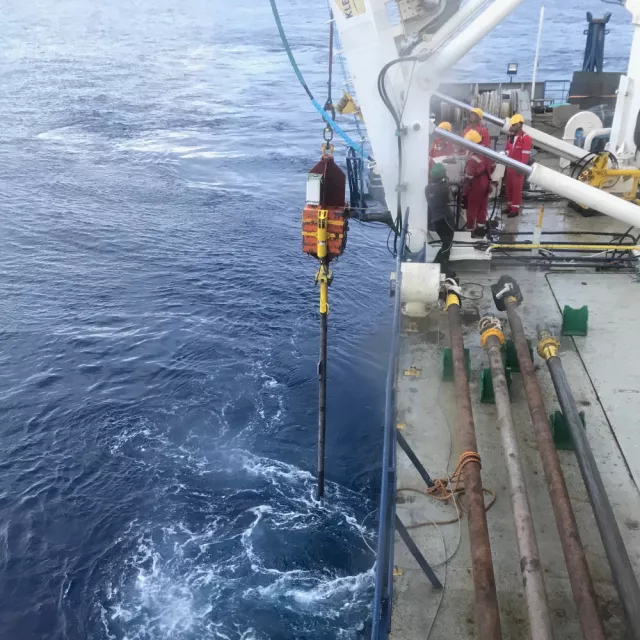Tracking climate change: Constructor University scientist conducts research off the coast of Brazil
A team of 60 international researchers on board the French research vessel "Marion Dufresne" is currently investigating the presence of gas hydrates, fluid venting and slope failures in the submarine sediments off the coast of Brazil to track the effects of climate change. Dr. Vikram Unnithan, Professor of Geosciences at Constructor University in Bremen, is the only scientist from a German university to join the first leg of the research expedition.
Rising temperatures can have severe and perpetual consequences for the edges of our continents that lie beneath the ocean- they can increase the potential for slope failures, underwater slides and enhanced gas emissions from the seafloor. As a result, such changes intensify the effect of climate change. "Even warming of one to two degrees Celsius has a huge impact on the seafloor, especially on the shelf edge, where such temperature changes combined with sea level fluctuations can lead to increased gas and fluid emissions," explained Unnithan, who compares this process to the melting of permafrost in the Arctic. It involves the release of methane and the creation of large holes and associated collapses and mudflows. "Understanding how this process works above and below the seabed is important for quantifying the emission gas fluxes, studying the potential impact of released gas on climate change, and evaluating the hazards from submarine slides and fluid venting episodes”, said Unnithan.

Image: Using a special technique, the research vessel can take cores up to 80 meters long without affecting the sediment to be recovered. (Source: Vikram Unnithan / Constructor University)
With a length of 120 meters, the Marion Dufresne is one of the largest research vessels in the world. But that is not the only reason why she is so special. Using a unique technique, the ship can take drill cores of up to 80 meters long without disturbing the recovered sediments. This is important for the detailed analyses of the sediments. The core samples are obtained in water depths of between 1,000 and 2,000 meters, with additional geophysical investigations reaching depths of up to 4,000 meters. Most of the samples are taken a few hundred miles off the coast of Brazil, on the Amazon Fan, an extension of the Amazon river, on the Brazilian shelf edge.
What the compositions of these gases are, how they formed, and how they rise from the seafloor are as much a part of the research as the effects of gas on triggering huge submarine landslides. "It's pioneering work in many ways that we are doing here. The spirit onboard is one of excitement and enthusiasm – it is a great privilege to work with some of the best scientists in this field," said Unnithan. The composition of the French-Brazilian project is not only international, but also interdisciplinary. On board are researchers from the fields of sedimentology, geochemistry, stratigraphy, geophysics or even geotechnics.
The geoscientist is involved in studying the cores and analyzing geophysical data collected during this research expedition, but he is particularly interested in data from the water column and understanding the relationships between the location of flares (gas emissions from the seafloor) and features beneath the seafloor (past slides, collapses, gas hydrates). "We are bringing back a huge amount of scientific information that will keep many researchers busy for decades to come," Unnithan said.
More information about the project:
https://univ-cotedazur.shorthandstories.com/campagne-AMARYLLIS/
Questions answered by:
Dr. Vikram Unnithan | Professor of Geosciences
vunnithan@constructor.university | Tel.: +49 421 200-3161
About Constructor University:
An international community, vibrant and diverse. Offering academic excellence, ensuring the highest standards in research and teaching. Empowering students to solve the world's pressing challenges through knowledge and science: Constructor University is a top-ranked, English-speaking, private university. Founded in 2001, it provides a wide range of 25+ academic programs and PhD. The Constructor ecosystem comprises the University, located in Bremen, Germany, and an institute in Schaffhausen, Switzerland.
Over 1.800 students from more than 110 nations on campus benefit from a unique interdisciplinary, foundational theoretical and practical education. Enriched with a buzzing entrepreneurial culture that prepares young professionals to thrive in the job market. With 6.000+ alumni worldwide, our community keeps growing – with our highest cohort ever registered in 2022.
The research-centric faculty projects are funded by the German Research Foundation and the European Union's Framework Program for Research and Innovation as well as by globally leading companies.
The Constructor ecosystem benefits from partnerships with high-ranked universities such as Carnegie Mellon, the University of Geneva or the National University of Singapore School of Computing, and technology companies such as Anisoprint, JetBrains and ChemDiv.
Constructor is a global institution dedicated to addressing the main challenges of the world through science, education, and technology. Apart from the University in Bremen, the ecosystem comprises an Institute in Schaffhausen (Switzerland) and several for-profit entities that provide technology infrastructures and solutions, life-long education programs, consulting services, and funding.
